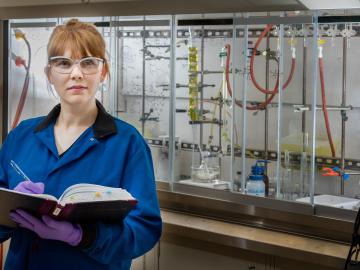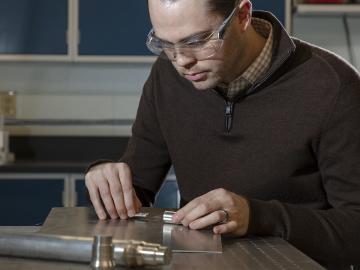
Filter News
Area of Research
- Advanced Manufacturing (13)
- Biological Systems (1)
- Biology and Environment (41)
- Building Technologies (2)
- Clean Energy (129)
- Climate and Environmental Systems (2)
- Computational Biology (1)
- Computational Engineering (3)
- Computer Science (12)
- Electricity and Smart Grid (1)
- Fusion and Fission (14)
- Fusion Energy (7)
- Isotopes (12)
- Materials (70)
- Materials for Computing (18)
- Mathematics (1)
- National Security (12)
- Neutron Science (39)
- Nuclear Science and Technology (12)
- Quantum information Science (6)
- Sensors and Controls (1)
- Supercomputing (52)
- Transportation Systems (2)
Date
News Topics
- 3-D Printing/Advanced Manufacturing (41)
- Advanced Reactors (9)
- Artificial Intelligence (19)
- Big Data (12)
- Bioenergy (22)
- Biology (23)
- Biomedical (15)
- Biotechnology (6)
- Buildings (13)
- Chemical Sciences (7)
- Clean Water (13)
- Climate Change (11)
- Composites (8)
- Computer Science (65)
- Coronavirus (10)
- Critical Materials (4)
- Cybersecurity (10)
- Decarbonization (7)
- Energy Storage (30)
- Environment (58)
- Exascale Computing (4)
- Frontier (6)
- Fusion (13)
- Grid (16)
- High-Performance Computing (19)
- Isotopes (13)
- ITER (4)
- Machine Learning (6)
- Materials (32)
- Materials Science (42)
- Mathematics (1)
- Mercury (4)
- Microscopy (15)
- Molten Salt (1)
- Nanotechnology (16)
- National Security (7)
- Net Zero (1)
- Neutron Science (36)
- Nuclear Energy (23)
- Physics (9)
- Polymers (7)
- Quantum Computing (5)
- Quantum Science (22)
- Security (5)
- Space Exploration (8)
- Statistics (1)
- Summit (18)
- Sustainable Energy (43)
- Transportation (33)
Media Contacts

In the shifting landscape of global manufacturing, American ingenuity is once again giving U.S companies an edge with radical productivity improvements as a result of advanced materials and robotic systems developed at the Department of Energy’s Manufacturing Demonstration Facility (MDF) at Oak Ridge National Laboratory.
The Department of Energy’s Oak Ridge National Laboratory has named Marcel Demarteau as Physics Division Director, effective June 17.

Oak Ridge National Laboratory welcomed seven technology innovators to join the third cohort of Innovation Crossroads, the Southeast’s only entrepreneurial research and development program based at a U.S. Department of Energy national laboratory.

An organic chemist at Oak Ridge National Laboratory, Santa Jansone-Popova focuses on the fundamental challenges of chemical separations that translate to world-changing solutions for clean water and sustainable energy.

The Department of Energy has established the Innovation Network for Fusion Energy program, or INFUSE, to encourage private-public research partnerships for overcoming challenges in fusion energy development.

For the first time, Oak Ridge National Laboratory has completed testing of nuclear fuels using MiniFuel, an irradiation vehicle that allows for rapid experimentation.

A study led by Oak Ridge National Laboratory explored the interface between the Department of Veterans Affairs’ healthcare data system and the data itself to detect the likelihood of errors and designed an auto-surveillance tool

Scientists have discovered a way to alter heat transport in thermoelectric materials, a finding that may ultimately improve energy efficiency as the materials

A team led by scientists at the Department of Energy’s Oak Ridge National Laboratory explored how atomically thin two-dimensional (2D) crystals can grow over 3D objects and how the curvature of those objects can stretch and strain the

With operating licenses for nearly all nuclear power plants set to expire in the 2030s and 40s—a pending loss that would affect a fifth of the country’s electricity supply—U.S. utilities will need to find a way to respond to what has been called the “nuclear cliff.”


